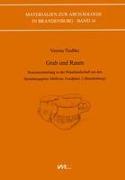Grab und Raum
BücherAngebote / Angebote:
This study investigates the cemetery of the Lusatian Culture at Müllrose, site 2, near Frankfurt an der Oder including its surroundings within a radius of 20 km in the North German-Polish upper moraine belt. It formed an anchor point in the ritual landscape of Eastern Brandenburg with its unfortified settlements during some 400 years from the 12th to 9th century B.C. [Bz D-Ha C1] and was only re-occupied in the 3rd century B.C.. Apart from ritual zones, seven burial groups can be localised. There is evidence for parallel economic circles for the living and the dead in resources such as space, wood, clay, and stones. The number of individuals of each demographic subgroup attests that all the deceased of the burying communities were actually deposited within the cemetery. The exclusive burial mode was cremation with pine wood at temperatures of 550-750 C. After this, specimens of all important body parts and cremated personal goods were selected and piled up in an anatomically correct order from feet to head in urns or urn-less grave pits. The division of cremated remains within a grave is also documented. The abandonment of the cemetery coincided with other disruptions of the Early Iron Age.
Folgt in ca. 2-3 Arbeitstagen




